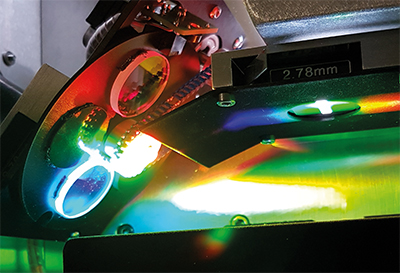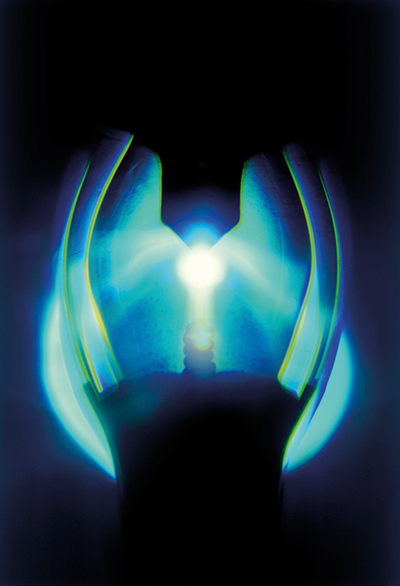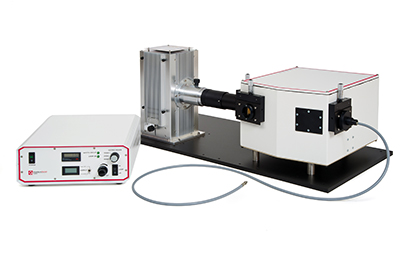High-power tunable monochromatic light source
With the spread of lasers, monochromatic light sources have been somewhat relegated to the background, which, in our opinion, is not what they deserve. Of course, due to their high power, their narrow bandwidths and their coherence, lasers are almost perfect monochromatic light sources. However, the limited spectral range is usually a disadvantage. Many lasers emit only one wavelength or offer a limited tuning range only. With a large tunable wavelength range and adjustable bandwidth,
a classic system comprising a light source and a monochromator offers clear advantages.
Light source
Almost all light sources can be combined with a monochromator. For the UV range up to 400 nm, deuterium or UV-enhanced xenon light sources are usually used. From 400 nm to the NIR range, halogen lamps can be used because of their uniform and smooth spectral behavior. However, the relatively large luminous filament, which leads to a low irradiance, is a disadvantage and limits efficient coupling into the monochromator. For this reason, xenon lamps are a preferred choice, since they achieve high luminance due to their very small arc, thus generating high power in the monochromatic light beam. They cover a wide spectral range from UV to about 2400 nm. But even this is not the limit for the tunable light source! For the remaining IR range up to more than 15 μm, IR emitters are available, which are adapted to the monochromator with suitable optics. Should the bandwidth of a single light source not be sufficient for your application, simply make use of one of our dual light sources with motorized exchangeable mirror. They combine deuterium/ halogen, halogen/IR or xenon and halogen elements in one housing.
Monochromator
The monochromator essentially determines the possible through-put and the achievable bandwidth of the monochromatic light source. In many cases, bandwidth requirements are not very high (>5 nm). In this case, a monochromator with a shorter focal length (e.g. 150 mm) will do. Smaller bandwidths require systems with longer focal lengths, e.g. 300 mm, as this is the only way to achieve slit widths that are large enough to allow efficient coupling of the light source. To be able to make use of a wide wavelength range, the monochromator should operate automatically with multiple gratings. Variable slits that are adjusted by hand or with motor power determine the bandwidth. If maximum precision and reproducibility are required, fixed slits are used.
Power output
Increasing output power is a recurring topic in our conversations with customers. Simply using a higher-power light source unfortunately does not always work. Sometimes this is even counter-productive. In most cases, this is due to the requirement to combine the lowest possible bandwidth with the highest possible power. A low bandwidth requires a small slit width, while high power is only possible with wide slits. Since the size of the arc of a lamp increases with electrical power consumption, it is possible that the additional power only heats the (too small) entrance slit, but does not contribute to a higher monochromatic power output.
High-power light source
To meet the demands for high monochromatic power, we offer a new 300 mm monochromator with notably improved optics. With 90 mm x 90 mm gratings (as compared to 68 mm x 84 mm in MSH300,) a significant increase in throughput can be achieved. To make full use of the power, the monochromator with asymmetric Czerny-Turner configuration is supplemented by a matched 450 W xenon light source with elliptical reflector. This way, almost 100% of the light output can be collected. This puts the system in a league of its own. In particular in the UV range starting from 200 nm, it achieves excellent values.
Accessories
The light exiting a monochromator is always divergent, corresponding to its f-number. For this reason, additional optics that guide the radiation to the location of the sample are required in most cases. Optical fibers offer high flexibility, but, depending on the f-number and the area, can also „swallow“ a large portion of the output. Lens or mirror-based collimators, depending on the wavelength, are a better solution. Depending on your application, integrating spheres and other accessories complete your setup.
Monochromator detector systems
For emission analysis, a single-element detector may be located at the exit of the monochromator. With a broad selection of different photomultipliers, Si and InGaAs photodiodes as well as cadmium telluride or lead selenide detectors, we cover a wide spectral range from 200 nm - 30 µm. Of course, the required control electronics and lock-in technology are also part of our offer.
This large variety allows for almost unlimited combination options, which will probably raise some questions. If you need support in planning a new or expanding an existing measuring station, we will be happy to assist you.
You can find an overview here.






